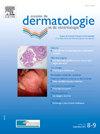时间对晚期黑色素瘤患者免疫治疗的影响及其疗效:一项回顾性观察性研究
IF 3.1
4区 医学
Q2 DERMATOLOGY
引用次数: 0
摘要
背景某些出版物指出,如果免疫疗法与免疫系统的昼夜节律同步,则会更加有效。患者和方法我们对接受免疫检查点抑制剂一线治疗的晚期皮肤黑色素瘤患者进行了一项单中心回顾性研究。我们将所有输液的中位时钟时间(11:00)作为区分上午和下午的分界点。根据患者50%的输液时间是在11:00之前还是之后,将他们分配到上午组还是下午组。计算倾向得分。结果我们纳入了2013年1月1日至2022年1月1日期间接受一线免疫疗法治疗的154名转移性患者,中位年龄为67岁(四分位间距:56-75岁)。晚期治疗与总生存期(中位数未达到[34.9-无法估计]对70.8个月;危险比(HR)=0.94[0.63-1.39])和无进展生存期(22.3对26.5;HR=0.99[0.71-1.38])均无关系,两组间的生存结果也无差异。下午组发生严重治疗相关 AEs 的频率明显高于上午组(分别为 33 [34%] 对 6 [11%],加权 p 值 = 0.004)。本文章由计算机程序翻译,如有差异,请以英文原文为准。
The impact of the time-of-day in the administration of immunotherapy and its efficacy in patients with advanced melanoma: A retrospective observational study
Background
Certain publications suggest that immunotherapy would be more effective if it were synchronised with the circadian oscillations of the immune system. We hypothesised that late treatment delivery in melanoma patients would correlate with worse survival outcomes.
Patients and methods
We conducted a monocentric retrospective study in patients with advanced cutaneous melanoma receiving immune checkpoint inhibitors as first-line therapy. We used the median clock time of all infusions (11:00) as the cut-off point to differentiate morning from afternoon. Patients were allocated to the morning or afternoon group depending on whether they had received >50% of their infusions before or after 11:00. A propensity score was calculated. Timing groups were assessed for association with overall and progression-free survival using a Cox proportional hazards model, survival curves were compared, and treatment-related adverse events (AEs) were analysed.
Results
We included 154 patients treated with frontline immunotherapy in a metastatic setting from 1 January 2013 to 1 January 2022, with a median age of 67 years (interquartile range: 56–75). Late treatment delivery was associated neither with worse overall survival (median not reached [34.9-not estimable] vs. 70.8 months; hazard ratio (HR) = 0.94 [0.63–1.39]) nor worse progression-free survival (22.3 vs. 26.5; HR = 0.99 [0.71–1.38]), and there were no differences in survival outcomes between the groups. Severe treatment-related AEs were significantly more frequent in the afternoon group than in the morning group (33 [34%] vs. 6 [11%] respectively, weighted p-value = 0.004).
Conclusion
Timing was not associated with worse efficacy outcomes, but morning administration appears to improve safety.
求助全文
通过发布文献求助,成功后即可免费获取论文全文。
去求助
来源期刊
CiteScore
1.40
自引率
0.00%
发文量
70
审稿时长
81 days
期刊介绍:
Les Annales de dermatologie sont le rendez-vous mensuel incontournable de toute la dermatologie francophone, grâce à leur comité de rédaction qui assure une sélection rigoureuse des articles selon les normes de l''édition scientifique internationale.
Une revue didactique, véritable aide à la pratique médicale quotidienne
Pour compléter et enrichir la partie scientifique, la rubrique Formation médicale continue propose aux lecteurs des textes didactiques et interactifs (Cas pour diagnostic, Notes de pharmacovigilance, la Question du praticien, Dermatologie chirurgicale, la Sélection bibliographique du mois...) qui les font bénéficier d''une formation post-universitaire diversifiée et de qualité. La revue consacre également un espace pour la publication de questions des lecteurs auxquelles des experts apportent une réponse.

 求助内容:
求助内容: 应助结果提醒方式:
应助结果提醒方式:


